Computer Systems
Created by Commodore Wilkan Targaryen on Sat Dec 21st, 2024 @ 1:18pm
Computer Systems
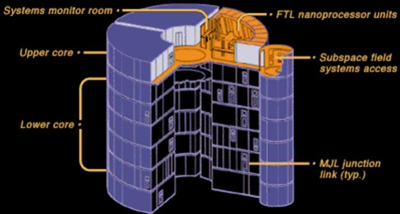 Perhaps the most important system aboard the Enterprise, the Computer Systems of the vessel are responsible for every function aboard the spacecraft and the ship would practically shutdown if the Computer Systems were to crash. Due to the capabilities of the Computer Systems of the Enterprise, many functions require an appropriate security clearance to allow access.
Perhaps the most important system aboard the Enterprise, the Computer Systems of the vessel are responsible for every function aboard the spacecraft and the ship would practically shutdown if the Computer Systems were to crash. Due to the capabilities of the Computer Systems of the Enterprise, many functions require an appropriate security clearance to allow access.The latest generation Computer Core aboard the Enterprise is the most advanced Computer System ever employed by the United Federation of Planets and is as close to a sentient computer system as Starfleet has ever come. Sophisticated artificial intelligence subroutines have been uploaded into the Computer System, allowing the computer to understand, and respond to verbal (and even nonverbal) communication. Through the Artificial Intelligence Monitoring Software (AIMS) the Enterprise's computer monitors everything happening aboard the ship, including the crew themselves based upon data received from their communicator badge. In an emergency AIMS will assess the situation and notify appropriate personnel to help resolve the situation as effectively as possible. Should the crew be unavailable AIMS can operate the ship based upon the last series of instructions given it by the crew. AIMS continually creates a backup copy of its mission status and parameters, allowing it to recover from a complete data purge by reverting to its most recent configuration.
The Library Computer Access and Retrieval System (LCARS) allows the crew to interact with the Main Computer through either verbal command or manipulation of a graphic interface. Through LCARS a crewmember can access nearly unlimited information, monitor ship systems, and perform their duties. These advancements are thanks to the Positronic Optical Storage Chip, which replaced the Isolinear Optical Chip in the 2430s. Based upon the pioneering work of Doctors Noonien Soong, Altan Soong, Bruce Maddox, and Agnes Jurati, the Positronic Chip is capable of processing incredible amounts of data in a short period of time. Their processing is supplemented by miniature subspace generators that allow the system to process data at faster than light speeds. While each Computer Core is capable of managing the entire starship, Starfleet policy requires that vessels the size of the Enterprise have at least three Computer Cores installed to ensure optimal functioning. In its current configuration the Enterprise has been equipped with four Positronic Computer Cores with two cores in each hull while a fifth Computer Core is located in the Engineering Hull is Isolinear based and is used if the other cores all fail. The Computer Cores are cylindrical structures that are 20 meters tall and 12 meters wide, spanning multiple decks and holding as many as 200,000 Positronic Chips. By regulation at least two of the Computer Cores are operational at all times to ensure the smooth operation of the ship; however, Enterprise maintains a minimum of three active cores during all flight modes with the remaining two on reserve should they be needed. The Computer Cores are supplemented by a network of subprocessors designed to handle some of the computational load in support of the Computer Core.
Artificial Intelligence Monitoring Software (AIMS)
 Artificial intelligence is an advanced computer system that features hardware and software sophisticated enough to reason independently, form new conclusions, and alter its own responses based upon experiences. Artificial intelligence software was created for many different reasons, which were normally programmed into the software; however, artificial intelligence software has never been able to achieve the sophistication of a humanoid brain, until the development of the Artificial Intelligence Monitoring Software, also known as AIMS.
Artificial intelligence is an advanced computer system that features hardware and software sophisticated enough to reason independently, form new conclusions, and alter its own responses based upon experiences. Artificial intelligence software was created for many different reasons, which were normally programmed into the software; however, artificial intelligence software has never been able to achieve the sophistication of a humanoid brain, until the development of the Artificial Intelligence Monitoring Software, also known as AIMS. An outgrowth of the EXEO Holographic Core and Emergency Support Holograms, AIMS is capable of billions of different tasks at once, and because of multiple parallel processors and quantum computing, can complete several billion calculations concurrently. Because of its abilities, AIMS is instrumental in almost all aspects of life aboard the Enterprise by helping to manage shipboard systems, monitor the external environment, and even assist with day-to-day tasks. In an emergency AIMS provides up to the minute assessments of the situation and will help to resolve the crisis based upon the instructions it has previously received from the crew.
The Artificial Intelligence represents the will of the starship and is often its voice, but the system is fiercely loyal to the ideals of the United Federation of Planets and is designed to follow the orders of the crew. Typically, AIMS is set to read only mode during most operations, requiring the system to operate within literal interpretations of their mission parameters. Depending upon the mission profile, the crew may choose to reset AIMS to a more complex read/write mode. When set to this mode, AIMS will use Adaptive Learning Software to independently learn and update its functions to better adapt to situations that the ship encounters through the ability to self-initiate tasks as it sees fit outside the usual requirement for direct efficiency. While this mode increases the Enterprise's ability to react to a situation, it allows the ship to engage in introspective analysis and even develop a personality. Often, AIMS will develop a holographic persona to allow the software to better interact with the crew.
AIMS is at risk of "death" through the loss of its memory and control pathways, which can occur if these items are wiped and removed from the system. This process renders AIMS incapable of performing basic functions and effectively eliminates any advanced functions that AIMS has developed while operating in read/write mode. This rarely occurs in combat and is usually a decision made by the crew of the vessel; however, erasure is a drastic step that is not often taken unless the safety of the ship and crew is at significant risk. Normally this process is accomplished through a Factory Reset implemented by the vessel's Commanding Officer. Under Factory Reset the software reverts to factory standard, removing all current files, protocols, and subroutines and reinstalling in the same condition they were in at launch.
Library Computer Access and Retrieval System (LCARS)
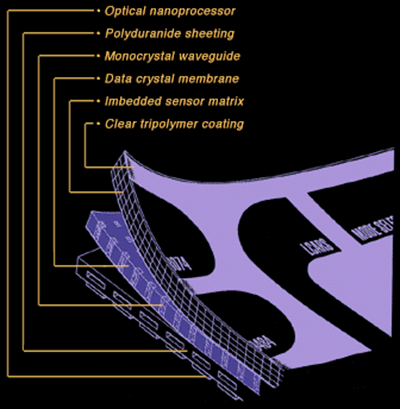 Separate from the Artificial Intelligence Monitoring Software the Library Computer Access and Retrieval System (aka LCARS) and replaced the Spacecraft Operating & Management System used in the 23rd Century. Deployed aboard Starfleet ships in the mid-24th Century, LCARS can be accessed from virtually anywhere aboard the spacecraft by either voice or keypad commands. Using sophisticated computer subroutines to process instructions received, LCARS enables complicated tasks to be completed after receiving only a few commands. LCARS also allows the retrieval and storage of files in the Enterprise's Computer Cores and can be used to retrieve files in external databases.
Separate from the Artificial Intelligence Monitoring Software the Library Computer Access and Retrieval System (aka LCARS) and replaced the Spacecraft Operating & Management System used in the 23rd Century. Deployed aboard Starfleet ships in the mid-24th Century, LCARS can be accessed from virtually anywhere aboard the spacecraft by either voice or keypad commands. Using sophisticated computer subroutines to process instructions received, LCARS enables complicated tasks to be completed after receiving only a few commands. LCARS also allows the retrieval and storage of files in the Enterprise's Computer Cores and can be used to retrieve files in external databases. Throughout the Federation control panels are used by crewmembers to access LCARS and perform their duties. LCARS interfaces maintain the same basic layout and design, but with a variety of color schemes employed during routine operations. In emergency situations LCARS color schemes were updated to reflect the current alert status with the interface switching their color pallet to match the alert level. Each interface features multilayered, flat touch-screen technology and incorporates data management software to produce a graphical interface for ease of access and use. Users can quickly reconfigure the panel to fit their preferences (with the computer storing the interface preferences) and operate the system by touching the appropriate keys on the screen. While LCARS can be deployed in a three-dimensional holographic interface touch sensitive interfaces remained the standard aboard Federation starships.
Optical Data Network
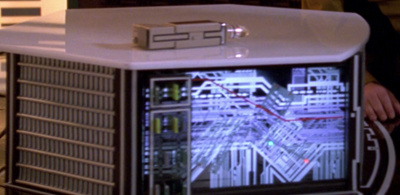 The Optical Data Network (also known as ODN) are a complex collection of multiplexed optical monocrystal microfibers that transmit data throughout the Starship Enterprise. In many way the ODN system are the nerves of the Enterprise, linking the Computer Cores to the various subprocessors and computer consoles aboard the ship. Century Class vessels incorporate multiple redundant ODN Trunks to ensure the stability of the Optical Data Network as damage to the ODN system would impact shipboard operations.
The Optical Data Network (also known as ODN) are a complex collection of multiplexed optical monocrystal microfibers that transmit data throughout the Starship Enterprise. In many way the ODN system are the nerves of the Enterprise, linking the Computer Cores to the various subprocessors and computer consoles aboard the ship. Century Class vessels incorporate multiple redundant ODN Trunks to ensure the stability of the Optical Data Network as damage to the ODN system would impact shipboard operations.
Positronic Optical Storage Chip
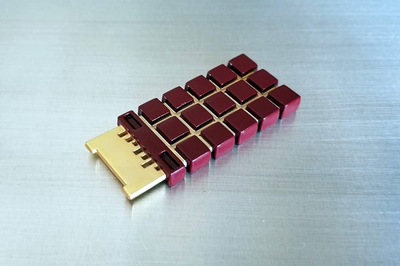 The most advanced computer chip devised by Starfleet, the Computer Cores of the Enterprise incorporate Positronic Optical Storage Chips that create an artificial neural network computer system that mimics a humanoid brain. Based upon the technology utilized in Soong Type Androids like Commander Data, the Positronic Chips use molecular memory and are capable of a base computational speed of roughly sixty trillion operations per second with a storage capacity of roughly eight hundred quadrillion bits (100 petabytes). When partnered with the Enterprise's Computer Core, the interlink sequencer of the chips recalibrate to an asynchronous mode of operation which removes performance constraints making the computational speed nearly instantaneous.
The most advanced computer chip devised by Starfleet, the Computer Cores of the Enterprise incorporate Positronic Optical Storage Chips that create an artificial neural network computer system that mimics a humanoid brain. Based upon the technology utilized in Soong Type Androids like Commander Data, the Positronic Chips use molecular memory and are capable of a base computational speed of roughly sixty trillion operations per second with a storage capacity of roughly eight hundred quadrillion bits (100 petabytes). When partnered with the Enterprise's Computer Core, the interlink sequencer of the chips recalibrate to an asynchronous mode of operation which removes performance constraints making the computational speed nearly instantaneous.While advanced, the Positronic Optical Storage Chips are still an experimental technology that are only utilized on a few starships. Already, the Positronic Chips have shown susceptibility to energy surges, which can disrupt programming inaccurate exchange information between file directories. A Positronic Decompiler could also be used to access the source code of the matrix of the Positronic brain=, allowing the existing code to be altered.
Navigational Computer
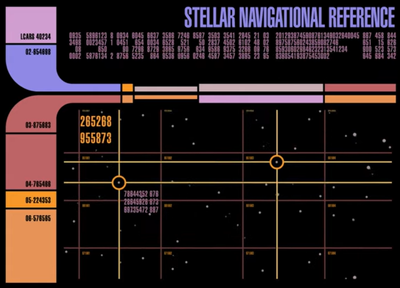 Due to the critical nature of navigation in ensuring the safety of the Federation Starship Enterprise, a dedicated Navigational Computer System has been installed aboard the ship to assist the Flight Control Officer and Astrometrics personnel. Typically, the Navigational Computer is installed directly into the Flight Control workstation on the Bridge of a Starship; however, due to the presence of experimental propulsion technologies aboard the vessel, the Enterprise's Navigational Computer is installed directly into the Main Computer Core. Should the vessel need to engage in high-speed travel using either its Coaxial Warp Drive or the Quantum Slipstream Drive the Navigational Computer begins processing the complex calculations needed to maintain these velocities safely. Should the Navigational Computer fail a backup system is available to take over.
Due to the critical nature of navigation in ensuring the safety of the Federation Starship Enterprise, a dedicated Navigational Computer System has been installed aboard the ship to assist the Flight Control Officer and Astrometrics personnel. Typically, the Navigational Computer is installed directly into the Flight Control workstation on the Bridge of a Starship; however, due to the presence of experimental propulsion technologies aboard the vessel, the Enterprise's Navigational Computer is installed directly into the Main Computer Core. Should the vessel need to engage in high-speed travel using either its Coaxial Warp Drive or the Quantum Slipstream Drive the Navigational Computer begins processing the complex calculations needed to maintain these velocities safely. Should the Navigational Computer fail a backup system is available to take over.
Attitude Control
Tied to the Navigational Computer and the Flight Controls, Attitude Control maintains the ship's position and keeps the ship properly oriented along its projected flight path. Different from the Inertial Dampening Field, loss of Attitude Control makes it difficult to steer the ship as the vessel will wobble, shake, and yaw uncontrolled.
Autopilot
Managed by the Navigational Computer, and supplemented by the Artificial Intelligence Monitoring Software, the autopilot flies the ship when a ship’s pilot or pilots are unable to do so.
Guidance and Navigation
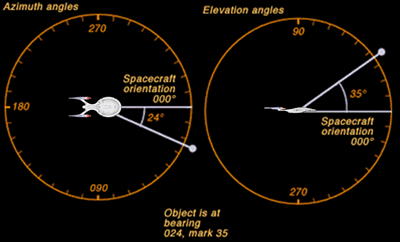 The Navigational Computer of the Starship Enterprise is responsible for interpreting and developing flight paths based upon the orders of the ship's Commanding Officer and input by the Flight Controller. During routine operations this process is relatively straightforward with the Enterprise's computer calculating the optimal flight path based upon one of the five methods of input. This process is accomplished by combining information from Starfleet's expansive star charts and comparing that information to data obtained by the Enterprise's sophisticated onboard sensors on the position of stellar activity. These two sources were then combined to more accurately calculate its location and the relative position of its destination based upon fixed points, such as the galactic center or Earth itself.
The Navigational Computer of the Starship Enterprise is responsible for interpreting and developing flight paths based upon the orders of the ship's Commanding Officer and input by the Flight Controller. During routine operations this process is relatively straightforward with the Enterprise's computer calculating the optimal flight path based upon one of the five methods of input. This process is accomplished by combining information from Starfleet's expansive star charts and comparing that information to data obtained by the Enterprise's sophisticated onboard sensors on the position of stellar activity. These two sources were then combined to more accurately calculate its location and the relative position of its destination based upon fixed points, such as the galactic center or Earth itself.The Helm Officers would enter a destination into the computer by one of the following methods:
- Destination Planet or System: The Helmsman would designate a specific celestial object or facility stored within the navigational database.
- Destination Sector: The computer would plot a course to the center of a particular sector, which was identified by either its ID number or name.
- Spacecraft Interception: The ship would plot a course to a designated craft identified by the ship's sensors, with speed determined by interception time or speed.
- Relative Bearing: Similar to Absolute Heading and rarely used, this process involved the Helm inputting a flight vector specified as an azimuth/elevation relative to the ship's orientation.
- Absolute Heading: Similar to Relative Bearing and rarely used, this process involves the Helm specifying an azimuth/elevation relative to the galactic center.
Threat Assessment/Tracking/Targeting System
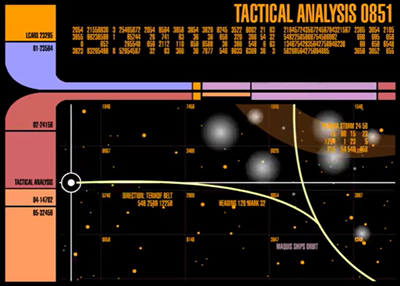 Better known as "Targeting Scanners," the Threat Assessment/Tracking/Targeting System (TA/T/TS) combines the Tactical Computer and Tactical Sensors into one package. Similar to the Navigational Computer, the TA/T/TS system on most vessels is built directly into the Tactical console; nonetheless, on the Enterprise, the system is much more robust and is incorporated into the Main Computer Core. The Tactical Computer is constantly reviewing data in an effort to uncover any threat to the safety of the vessel, which is enhanced during combat maneuvers to ensure the most efficient deployment of weapons to defeat an opponent's attack. The system recommends the best targeting locations through a thorough analysis of any opponent detected and can be set to automatically target threats. A priority target in a fight, the TA/T/TS System incorporates redundant backups that can be brought online in seconds of the primary system having been taken offline. In addition to its role involving the shipboard weapons and defenses, the Targeting Scanners are also used to establish a Transporter Lock on a target.
Better known as "Targeting Scanners," the Threat Assessment/Tracking/Targeting System (TA/T/TS) combines the Tactical Computer and Tactical Sensors into one package. Similar to the Navigational Computer, the TA/T/TS system on most vessels is built directly into the Tactical console; nonetheless, on the Enterprise, the system is much more robust and is incorporated into the Main Computer Core. The Tactical Computer is constantly reviewing data in an effort to uncover any threat to the safety of the vessel, which is enhanced during combat maneuvers to ensure the most efficient deployment of weapons to defeat an opponent's attack. The system recommends the best targeting locations through a thorough analysis of any opponent detected and can be set to automatically target threats. A priority target in a fight, the TA/T/TS System incorporates redundant backups that can be brought online in seconds of the primary system having been taken offline. In addition to its role involving the shipboard weapons and defenses, the Targeting Scanners are also used to establish a Transporter Lock on a target.
Anti-Intruder System
Tied closely to the Internal Security Sensors, the Anti-Intruder System is a subsystem of the Enterprise's Threat Assessment/Tracking/Targeting System designed to incapacitate hostile forces that have invaded the vessel. Normally, the Anti-Intruder System can be used to trap an intruder behind a containment field until a Security Team can be deployed to capture the target. Should the intruder attempt to access the Computer Systems the Anti-Intruder System can also deploy a mild electric shock - similar in strength to a Level 1 Phaser setting - to incapacitate the intruder.
Command Authorization and Security Clearance
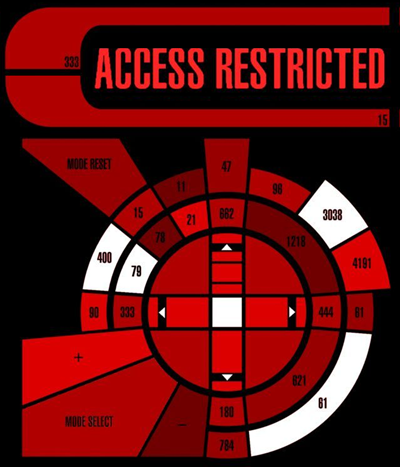 Managed by the Threat Assessment/Tracking/Targeting System, personnel assigned to all Federation Starships are assigned various levels of access to command functions and information. Authorization is identified by an alphanumeric sequence known as an Authorization Code, which are standardized passwords that include the user's last name, Greek letters, and a numerical sequence. Codes are normally verbally entered into the computer (they can also be typed into a keypad) to confirm authorization. By default users are required to enter their password each time they access sensitive information, but the Artificial Intelligence Monitoring Software could be set to remember the user based upon their genetic profile. By policy a user's codes must be changed on a 90 day basis to prevent sabotage and security breaches.
Managed by the Threat Assessment/Tracking/Targeting System, personnel assigned to all Federation Starships are assigned various levels of access to command functions and information. Authorization is identified by an alphanumeric sequence known as an Authorization Code, which are standardized passwords that include the user's last name, Greek letters, and a numerical sequence. Codes are normally verbally entered into the computer (they can also be typed into a keypad) to confirm authorization. By default users are required to enter their password each time they access sensitive information, but the Artificial Intelligence Monitoring Software could be set to remember the user based upon their genetic profile. By policy a user's codes must be changed on a 90 day basis to prevent sabotage and security breaches. Command Authorization represents the level of control a user has over the Enterprise, including their ability to issue commands, access the computers, or control shipboard systems. Known was Alpha-Two Clearance, both the Commanding Officer and Executive Officer have the highest level of authority aboard the Enterprise; however, orders issued by the Captain will override all other orders given, including those of the Executive Officer, except those of an Admiral. Senior Staff have high access, but they are unable to localize command functions. Security Clearance is the level of authority given to a member of the Enterprise's crew based upon their rank, status, and/or position aboard the spacecraft. Dependent upon the responsibilities of the crewmember, a user's Security Clearance is used to access information from the vessel's computers or to complete certain tasks. If necessary, a user's clearance could be upgraded to a higher level, transferred to another officer, or terminated by order of the Commanding Officer, Executive Officer, Chief Operations Officer, of the Chief Security Officer.
Security Clearance | ||||
| Commanding Officer | All Flag Ranks Captain (Enterprise) |
Alpha Two | 10 | User has unlimited access to all command functions, computer records, and shipboard systems, including the ability to localize command functions. |
| Executive Officer | Captain | Alpha Two | 09 | User has unlimited access to all command functions, computer records, and shipboard systems, including the ability to localize command functions. |
| Second Officer Chief Engineering Officer Chief Flight Control/Operations Officer |
Commander | Alpha One | 08 | User has unlimited access to all command functions, computer records, and shipboard systems, but no ability to localize command functions. |
| Chief Medical Officer Chief Science Officer Chief Security/Tactical Officer Assistant Chief Engineering Officer Assistant Chief Flight Control/Operations Officer |
Lieutenant Commander | Beta Two | 07 | User has unlimited access to all computer records and shipboard systems, but limited access to command functions. |
| Assistant Chief Medical Officer Assistant Chief Science Officer Assistant Chief Security/Tactical Officer Engineering Officer Flight Control/Operations Officer Medical Officer/Counselor |
Lieutenant Master Chief Petty Officer |
Beta One | 06 | User has unlimited access to all computer records, but limited access to command functions and systems related to their duties. |
| Medical Officer Science Officer Security/Tactical Officer Engineering Specialist Transporter Specialist |
Lieutenant (Junior Grade) Chief Warrant Officer Senior Chief Petty Officer |
Gamma Two | 05 | User has limited access to command functions, computer records, and shipboard systems related to their duties. |
| Nurse Pilot Science Specialist Yeoman |
Ensign Master Warrant Officer Chief Petty Officer |
Gamma One | 04 | User has limited access to computer records and shipboard systems related to their duties, but no access to command functions. |
| Civilian Consultants | Staff Warant Officer Petty Officer 1st, 2nd, and 3rd Class | Delta Two | 03 | User has limited access to computer records and monitored access to shipboard systems, but no access to command functions or shipboard systems. |
| Cadet Warrant Officer Crewman Recruit Crewman Apprentice Crewman Civilian Personnel |
Delta One | 02 | User has limited, monitored access to computer records related to their duties, but no access to command functions or shipboard systems. | |
| 01 | User has access to open records only with no access to command functions, computer records, or shipboard systems. | |||
Prefix Code
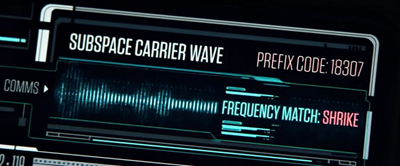 As more and more sophisticated opponents were encountered by the United Federation of Planets, Starfleet started to run to risk of losing access to their vessels through the actions of bad actors both from outside of Starfleet and even inside the organization. Early in the 23rd Century Starfleet Command issued an operational order to Starfleet Security requesting that a procedure be developed to recover a Starfleet vessel in the event that it was hijacked by a hostile force. Soon afterward the concept of the Prefix Code was introduced into all Starfleet vessel's Computers, managed by the Threat Assessment/Tracking/Targeting System.
As more and more sophisticated opponents were encountered by the United Federation of Planets, Starfleet started to run to risk of losing access to their vessels through the actions of bad actors both from outside of Starfleet and even inside the organization. Early in the 23rd Century Starfleet Command issued an operational order to Starfleet Security requesting that a procedure be developed to recover a Starfleet vessel in the event that it was hijacked by a hostile force. Soon afterward the concept of the Prefix Code was introduced into all Starfleet vessel's Computers, managed by the Threat Assessment/Tracking/Targeting System.The Prefix Code is a classified code installed inserted into the operational coding of every system aboard a starship. This defensive protocol allows Starfleet personnel to access the computer systems of a vessel that had been seized by hostile forces and override any command received by that vessel's main computer. Originally, each prefix code consisted of a numeric code of varying length; nevertheless, this process changed in the late 2380s to consist of an alpha-numeric code that was accessible only to the Commanding Officer of a vessel and Starfleet Command.
Unique to each starship, when a Prefix Code was utilized the user could control that vessel from either aboard the ship or at a distance. When aboard the vessel the Prefix Code could be entered from any workstation and authenticated by bio-signature, unless computer access had been isolated to a specific location at which point the user would have to enter the code from that location. In the event that the code was being entered from another starship, the vessel would open communications and send a background data packet containing the code to take remote control over the other vessel. Once entered the user could control any system aboard the ship, including the engines, weapons, and defenses.
Starfleet Command routinely monitors the Prefix Codes of all Starships within Starfleet and access to the Prefix Code is restricted to Level 10 Clearance aboard Federation vessels. In the event that someone attempted to modify the Prefix Code, so long as the vessel was within range of Starfleet, the Main Computer would notify Starfleet Security via secure data packet of its location and initiate its return protocol. In the event that a Compromised Prefix Code was submitted the computer would immediately notify the Starship of the location of the attempted infiltration, which is a strategy often used by Starfleet Captains when they have been captured.
Categories: Command | Tactical | Personnel | Operations | Science